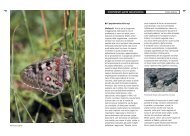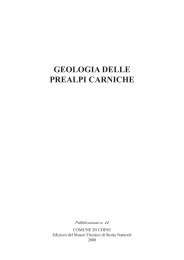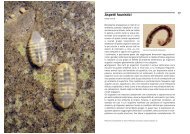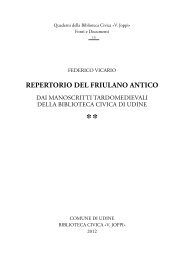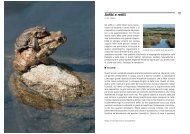Despite its inhospitable appearance and lack of any ... - Udine Cultura
Despite its inhospitable appearance and lack of any ... - Udine Cultura
Despite its inhospitable appearance and lack of any ... - Udine Cultura
Create successful ePaper yourself
Turn your PDF publications into a flip-book with our unique Google optimized e-Paper software.
94 ■ Ecology <strong>of</strong> springs<br />
95<br />
The perennial underground stream <strong>of</strong> the Pod Lanisce cave (Julian Pre-Alps, Friuli Venezia Giulia)<br />
Springs are like windows opening<br />
on the underground environment -<br />
Botosaneanu, a Romenian researcher,<br />
defined them as “the gates to the river<br />
Styx”. They are <strong>of</strong>ten the only means<br />
<strong>of</strong> analysing aquifers, because they are<br />
composed <strong>of</strong> surfacing groundwater<br />
which filters into recharge zones at<br />
different times, <strong>and</strong> reach spring<br />
points due to gravity. Springs may<br />
therefore be studied from the “outside”<br />
to analyse surface organisms<br />
colonising the crenal zone (thus, crenobiology), or from the “inside”, to<br />
examine the fauna <strong>of</strong> the aquifers supplying them - the stygian zone (thus,<br />
stygobiology).<br />
Springs are particular physical environments which have constant temperature<br />
over time <strong>and</strong> sometimes undergo changes in the chemical composition <strong>of</strong> their<br />
waters, due to the nature <strong>of</strong> the aquifers supplying them. These parameters<br />
define extreme natural situations. For instance, according to their thermic<br />
regime, there are thermal springs (like those in the Euganean Hills (Veneto),<br />
which host an endemic species <strong>of</strong> gastropods <strong>of</strong> the genus Heleobia) <strong>and</strong><br />
glacial ones (such as those in the Adamello-Brenta, between Lombardy <strong>and</strong><br />
Trentino, which are colonised by endemic stygophilic harpacticoid copepods).<br />
Brackish springs are saline (like the Poiano springs in Emilia Romagna, whose<br />
exclusive guest is the stygobiotic amphipod crustacean Niphargus poianoi),<br />
<strong>and</strong> those with particular values <strong>of</strong> pH <strong>and</strong> hydrogen sulphide, i.e., sulphuric<br />
springs, which are found throughout Italy <strong>and</strong> <strong>its</strong> isl<strong>and</strong>s.<br />
■ Groundwater inhabitants<br />
Sulphuric spring: the saline waters <strong>of</strong> Nirano<br />
(Emilia Romagna)<br />
The “darkness syndrome”. Contrary to ideas in the past, the underground<br />
environment can host great biodiversity. As described in the previous section,<br />
groundwater species may be divided into stygoxenes, stygophiles <strong>and</strong><br />
stygobionts, according to their degree <strong>of</strong> dependency on this habitat for their<br />
survival.<br />
Stygobionts are species which are exclusive to groundwater <strong>and</strong> have<br />
developed special adaptations to life in this habitat. All their adaptations




